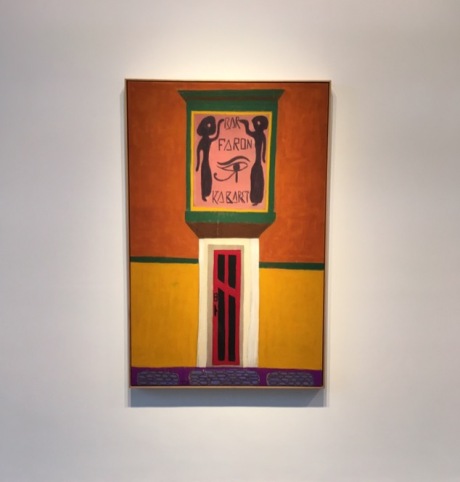Tal R’s ‘no comment’ comment on sex shops is a reasonably attractive exhibition with no substance. The works are interesting in themselves, but the artist’s decision to paint supposedly unbiased images of sex shops he has never visited across the globe is a dead end. If Tal R is making ‘non-judgemental’ images of sex shops with no comment whatsoever then all he is doing is drawing attention to the existence of sex shops, which everybody knows exist. Thank you for your input.

‘Allenby’ by Tal R
Ignoring the imposed artificial a-political political element of the show, the works themselves are quite interesting. Tal R’s use of pigment and rabbit skin glue, made much of in the gallery interpretation, makes for richly coloured and glittering canvases. The vibrancy lends a Vegas air to some works, such as Valencia, where a glimmering Wizard of Oz curtain and a glowing chandelier invite the viewer through a doorway at the centre of the painting. The colours are uplifting, and the only monochrome work, Pussy cat, feels very bleak in comparison to the rest.

‘Valencia’ by Tal R
Formally, the works are varied and engaging. Some, like Allenby and House 44 have a strong sense of perspective, while others like The Pleasure and Babylon are entirely flat, emphasising the plane of the canvas. Tal R renders architectural styles with skill; you can feel the different locations of the paintings. Bar Farao expresses bright, harsh sunlight; heat radiates out of the painting. Whether it’s the Eye of Horus atop the door or just the warmth of the colours, this work feels Mediterranean. There is a strong sense of location in these works.

‘Bar Farao’ by Tal R
Overall, the formal aspects of the paintings are far superior to the content. These works are not made more interesting by being images of sex shops. This show offers nothing in regards to any current debates around sex, gender, or respectability politics, but uses the existence of the debate to lure people in. Tal R exploits the existence of politically charged spaces and the people within them to add an element of interest to his works. Perhaps next time he should paint pubs.



